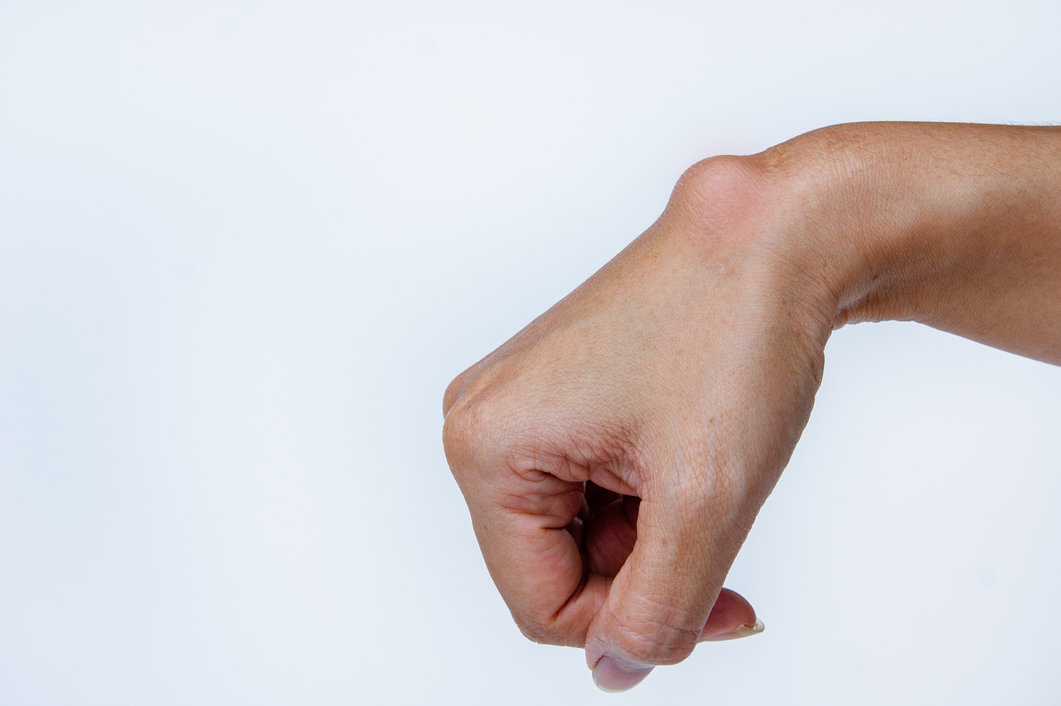Miss Shamim Umarji
Consultant Orthopaedic Surgeon
Specialist expertise: Hand and Wrist Problems, Sports Injuries, Orthopaedics, Carpal Tunnel, Cubital Tunnel, Trigger Finger, Arthritis, Hand & Wrist.
Ganglia are common lumps found around the hand, wrist and fingers, just beneath the skin.

Ganglia are common lumps found around the hand, wrist and fingers, just beneath the skin. They consist of thin-walled sacs containing thick gel like fluid and originate from tendons or joints. They can occur in most parts of the hand but are most commonly found on the back of the wrist (from the wrist joint) front of the wrist near the base of the thumb (from the wrist joint or tendon) or at the back of the tip of fingers (usually from an underlying arthritic joint). The latter is also known as a mucoid cyst.
Cysts are usually associated with degenerative change affecting the underlying tendon or joint. Most of this change is from chronic wear but occasionally can follow trauma and develop more rapidly.
Ganglia present as painful or painless lumps. Pain is usually due to the underlying cause i.e. the worn and inflamed joint or tendon. In some cases they are entirely painless bug are unsightly
Ganglia can easily be diagnosed by their appearance and location. They are usually smooth, round and fluctuant. They can be very tense and mistaken for a bony lump. Sometimes a scan is helpful in detecting the extent and size, before removal.
Ganglia will often spontaneously disappear or become painless over time. They can certainly be left untreated.
In general terms treatment can be offered as follows:
Ganglia generally do not need treatment and many of the presenting symptoms can be traced to the underlying cause of the ganglion, which is a secondary issue. A common misconception is that they can be treated by hitting with a heavy blow. This simply disperses the cyst which then recurs and this makes eventual thorough surgery more difficult. Surgery which removes the entire ganglion, often intact, can be followed by recurrence in a minority of cases.
Dorsal wrist ganglia
These can occasionally be associated with an injury to the underlying wrist ligaments (MRI scan can be helpful). While the ganglion can be removed it is usual to investigate the underlying cause, so as to plan treatment and possibility of persistence of symptoms.
Surgery can be performed under local, regional (the arm is numbed) or general anaesthetic. Complications include a scar on the back of the wrist, temporary stiffness of the wrist, numbness around the scar and recurrence. These should be discussed with your surgeon.
Palmar wrist ganglia
These are more likely to require surgery since they are often more painful than those on the back of the wrist. Surgery can be performed under local, regional (the arm is numbed) or general anaesthetic. Complications include recurrence and stiffness.
Flexor Tendon Sheath ganglion cyst
These are a nuisance and present as a tender, pea-sized nodule in the palm of the hand or anywhere along the finger. They can affect grip and dexterity. Some surgeons will propose lancing with a needle and others will advise surgical removal under local anaesthetic.
Dorsal Finger Ganglion cyst
These are common in patients with underlying arthritis or ‘wear and tear’ of the underlying joint at the tip of the finger. They present as a prominent, thin skinned, lump at the curve of the nail base. They often cause ridging or grooving of the fingernail.
Surgery can be performed under digital anaesthesia the finger is numbed. This permits the opportunity to trim any bony lumps to improve appearance and discourage recurrence. The skin over the ganglion is often thin and must be removed. This requires a local skin flap – a segment of skin from further along the finger moved to cover the site of removal of the ganglion. This too helps prevent recurrence.
Currently selected day
Available consultations
We boast a truly integrated team of orthopaedic surgeons, sports medicine physicians, podiatric surgeons, rheumatology specialists, paid medicine consultants and hand therapy specialists. All of these services work together in one place, enabling us to give patients the best care possible.